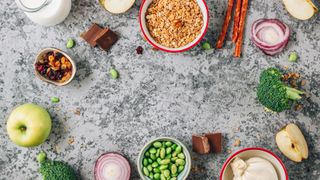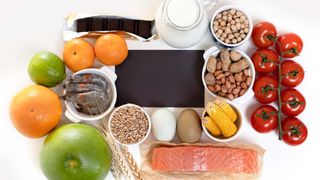How to do an elimination diet
An elimination diet can be a great option for those experiencing conditions like IBS and GERD. Here’s how to follow one safely

An elimination diet can be a useful tool for controlling unpleasant symptoms of gastrointestinal conditions, such as irritable bowel syndrome (IBS) and Gastroesophageal Reflux Disease (GERD). Often, symptoms can be intense, painful and even confusing when you aren’t sure what is triggering you.
First things first: you should not undertake an elimination diet without consulting your doctor, who may refer you to a dietician to help support you through the process. There is a risk of developing nutritional deficiencies with any major dietary change and it is important to ensure that you are following the diet effectively for the best results. Many foods contain ingredients that you wouldn’t necessarily expect, which could derail your elimination diet, so keeping a food diary and working with a dietician can make this process easier.
Find out more about gut health and how to improve your digestion here at Live Science.
What is an elimination diet?
There are multiple reasons why someone might try an elimination diet. If you experience troubling gastrointestinal symptoms, you may want to cut out certain foods to help you to identify the cause of your issues.
Common elimination diets include the low FODMAP diet, or the Six Food Elimination Diet, which generally take place over several weeks or months. The Journal of Gastroenterology and Hepatology advises not to exceed six weeks at the elimination stage, particularly for the low FODMAP (Fermentable Oligo-, Di-, Mono-saccharides, and Polyols) diet, as you can negatively affect your gut microbiome.
“An elimination diet is a method of identifying foods that a person is intolerant or sensitive to,” explains Rachel Clarkson, a Doctify-reviewed dietician and nutritionist, and the founder of The DNA Dietitian. “An individual may start an elimination diet to help identify the problematic foods in their diet causing symptoms.

Rachel Clarkson is an HCPC registered Specialist Dietitian and Nutritionist. She trained at King’s College London in the United Kingdom and underwent further clinical training at The Royal Marsden, St Thomas’s Hospital and Imperial College Trust. She recently published her epigenetic research from King's College London in a peer reviewed medical journal and continues with professional development with courses in subjects such as the low FODMAP diet for IBS management.
“The duration of an elimination diet can vary depending on the type and how many foods are being eliminated and then reintroduced or challenged. One of the most used and scientifically backed elimination diets is the low FODMAP diet. This diet excludes foods that contain compounds called FODMAPS that cause digestive symptoms in individuals with IBS. This elimination diet can take anywhere from 10-16 weeks for all three phases: elimination, reintroduction and personalization.”
High FODMAP foods include some vegetables such as onion and garlic, some fruits (especially stoned fruits), beans and lentils.
“Reviewing triggering foods or ingredients that may be aggravating symptoms will be helpful so completing a food and symptom diary may be a sensible approach,” adds Kim Plaza, a nutritionist with Bio-Kult.
How to follow an elimination diet
If you suspect you have a particular trigger food (such as dairy or gluten) it is worth cutting this out for a few weeks to see if your symptoms improve. However, if you aren’t sure what your trigger foods may be, or have been diagnosed with a particular condition that may benefit from a broad-spectrum elimination diet, you should follow the below steps under the guidance of a doctor.

Elimination
“This phase is typically 2-6 weeks in which all potentially problematic foods are eliminated from the diet,” explains Clarkson. “By the end of this phase symptoms should have completely subsided.”
A Nutrients journal review indicates that the low FODMAP diet in particular significantly reduced bloating and pain in subjects. A clinical trial reported in the Journal of Allergy and Clinical Immunology also found that an elimination diet achieved remission in 43% of study participants with eosinophilic esophagitis, regardless of age.
Reintroduction
The reintroduction phase involves systematic testing of each food group that has been eliminated.
“This phase can take anywhere between 4-8 weeks, depending on the number of foods that are being challenged,” says Clarkson. “During this phase, individuals should continue to eliminate all problematic foods, with the addition of the food that is being challenged to assess if it is causing the problematic symptoms. Each potentially problematic food is challenged individually and the quantity is incrementally increased to understand if the person is intolerant to this food and in what quantity symptoms start to present.”
Integration/Personalization
The final phase of an elimination diet is where the results of the food challenges are reviewed and discussed, says Clarkson.
“Additionally, other challenges may be prescribed in which more than one problematic food is introduced at the same time. Finally, the use of supplements, digestive enzymes or probiotics may be discussed.”
What can you eat on an elimination diet?
It is advisable to cook your meals using raw ingredients at this stage, so you know exactly what you’re consuming. Often processed foods contain flavorings, such as onion or garlic powder, which can trigger symptoms even in small amounts.
- Unprocessed meat and fish (not shellfish)
- Rice-based foods
- Dairy-free fats, such as vegetable oils
- Low FODMAP fruits and vegetables
What can’t you eat on an elimination diet?
The most common dietary triggers are often the first that should be eliminated to test symptom response:
- Dairy
- Wheat and rye
- Nightshade vegetables (e.g. potatoes, tomatoes and peppers)
- Shellfish
- Nuts and seeds
- Alliums (onions and garlic are high in FODMAPs and cause irritation for many people)
- Legumes
- Citrus fruits (these can be triggering for those with acid reflux and GERD)

Plaza also says that heavily processed foods can be problematic. “Processed foods that contain many hidden sugars, sweeteners, additives and emulsifiers are likely to have a negative impact on the bacteria living in the gut – therefore leading to increased inflammation and a worsening of IBS symptoms,” she says. “Many people notice a rapid improvement in their digestion just by cutting out processed foods and instead switching to a home-cooked wholefoods.”
What are the benefits of an elimination diet?
According to Clarkson, identifying your trigger foods can help you make the best decisions for your body. “The main benefit of an elimination diet is to be able to identify the foods that are causing symptoms and in what quantity these foods cause the symptoms,” she says. “This is a great benefit because it allows you to make the best choices for your body and helps you understand your body at a deeper level.”
Are there any risks of an elimination diet?
On an elimination diet, you need to be careful to ensure that you are still receiving your recommended daily amount of each nutrient, and as such you should do them under professional supervision.
“There can be risks of eliminating food groups for an extended period of time,” says Clarkson. “Working with a healthcare professional can ensure you carry out the elimination diet correctly and in the safest way.”
This article is for informational purposes only and is not meant to offer medical advice.
Sign up for the Live Science daily newsletter now
Get the world’s most fascinating discoveries delivered straight to your inbox.

Lou Mudge is a health writer based in Bath, United Kingdom for Future PLC. She holds an undergraduate degree in creative writing from Bath Spa University, and her work has appeared in Live Science, Tom's Guide, Fit & Well, Coach, T3, and Tech Radar, among others. She regularly writes about health and fitness-related topics such as air quality, gut health, diet and nutrition and the impacts these things have on our lives.
She has worked for the University of Bath on a chemistry research project and produced a short book in collaboration with the department of education at Bath Spa University.
